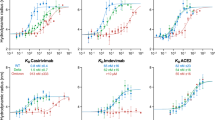Summary
Zidovudine (ZDV) is widely used in patients with HIV infection. Although major pharmacokinetic parameters have been evaluated with comparable results, the available data so far on the protein binding of ZDV in serum are contradictory. A method for the determination of the unbound drug in sera was used to investigate different experimental conditions possibly affecting the protein binding of ZDV. Protein binding was assessed in ‘spiked’ sera (ZDV 10 μmol/L) from 15 healthy controls as well as in sera from 10 human immunodeficiency virus (HIV)-infected patients on treatment. The protein binding of ZDV was found to be the same in plasma and serum, and was not affected by freezing and subsequent thawing of samples. Protein binding was strongly dependent on pH, and increased from 14.0 ± 0.6% at pH 6.7 to 31.9 ± 4.0% at pH 8.8 (p < 0.05). Furthermore, protein binding was dependent on temperature, and decreased from 17.9 ± 0.7% at room temperature to 10.8 ± 0.4% at 37°C. Protein binding (at room temperature and pH 7.4) was found to be comparable in spiked sera from the healthy volunteers (19.0 ± 0.7%) and in sera from the HIV-infected patients receiving ZDV treatment (18.7 ± 2.3%). Equilibrium binding studies were suggestive of two binding sites with KdS of 262 ± 72 μmol/L (high affinity) and 3566 ± 785 μmol/L (low affinity), respectively. Assuming physiological conditions, we found that protein binding of ZDV was as low as 11%. This indicates that binding of ZDV to serum proteins contributes only to a minor extent to the pharmacokinetic properties of this drug.
Similar content being viewed by others
References
Balis FM, Pizzo PA, Eddy J, Wilfert C, McKinney R, et al. Pharmacokinetics of zidovudine administered intravenously and orally in children with human immunodeficiency virus infection. Journal of Pediatrics 114: 880–884, 1989
Blum MR, Liao SH, Good SS, De Miranda P. Pharmacokinetics and bioavailability of zidovudine in humans. American Journal of Medicine 85 (Suppl. 2A): 189–194, 1988
Burroughs-Wellcome Product Information (‘Standardinformationen für Krankenhausapotheker’) p. 3, 1987
Collins JM, Klecker RW, Kelley JA, Roth JS, McCully CL, et al. Pyrimidine dideoxyribonucleosides: selectivity of penetration into cerebrospinal fluid. Journal of Pharmacology and Experimental Therapeutics 245: 466–470, 1988
Fischl MA, Richman DD, Grieco MH, Gottlieb MS, Volberding PA, et al. The efficacy of azidothymidine (AZT) in the treatment of patients with AIDS and AIDS-related complex. New England Journal of Medicine 317: 185–191, 1987
Good SS, Reynolds DJ, De Miranda P. Simultaneous quantification of zidovudine and its glucuronide in serum by high-performance liquid chromatography. Journal of Chromatography 431: 123–133, 1988
Hedaya MA, Elmquist WF, Sawchuk RJ. Probenecid inhibits the metabolic and renal clearances of zidovudine (AZT) in human volunteers. Pharmacological Research 7: 411–417, 1990
KJecker RW, Collins JM, Yarchoan R, Thomas R, Jenkins J, et al. Plasma and cerebrospinal fluid pharmacokinetics of 3’-azido3’-deoxythymidine: a novel pyrimidine analogue with potential application for the treatment of patients with AIDS and related diseases. Clinical Pharmacology and Therapeutics 41: 407–412, 1987
Notarianni LJ. Plasma protein-binding of drugs in pregnancy and in neonates. Clinical Pharmacokinetics 18: 20–36, 1990
Langtry HD, Campoli-Richards DM. Zidovudine — A review of its pharmacodynamic and pharmacokinetic properties, and therapeutic efficacy. Drugs 37: 408–450, 1989
Pizzo PA, Eddy J, Falloon J, Balis FM, Murphy RF, et al. Effect of continuous infusion of zidovudine (AZT) in children with symptomatic HIV infection. New England Journal of Medicine 319: 889–896, 1988
Rolinski B, Wintergerst U, Matuschke A, Füessl H, Goebel FD, et al. Evaluation of saliva as a specimen for monitoring zidovudine therapy in HIV-infected patients. AIDS 5: 885–888, 1991
Tillement JP, Albengres E, Urien S. Methodological aspects of the evaluation of the binding of drugs to plasma and tissue proteins. European Journal of Drug Metabolism and Pharmacokinetics 3: 123–127, 1979
Unadkat JD, Collier AC, Crosby SS, Cummings D, Opheim KE, et al. Pharmacokinetics of oral zidovudine (azidothymidine) in patients with AIDS when administered with and without a high fat meal. AIDS 4: 229–232, 1990
Volberding PA, Lagakos SW, Koch MA, Pettinelli C, Myers MW, et al. Zidovudine in asymptomatic human immunodeficiency virus infection. New England Journal of Medicine 322: 941–949, 1990
Author information
Authors and Affiliations
Rights and permissions
About this article
Cite this article
Rolinski, B., Wintergerst, U., Sadri, I. et al. Protein Binding of Zidovudine in the Sera of Healthy Controls and Patients Infected with Human Immunodeficiency Virus. Drug Invest 5, 166–172 (1993). https://doi.org/10.1007/BF03258442
Published:
Issue Date:
DOI: https://doi.org/10.1007/BF03258442




